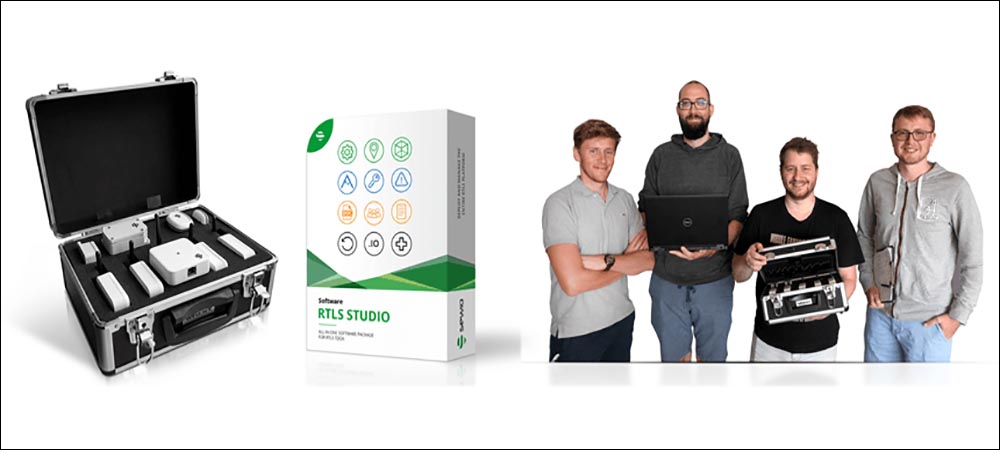This fall, three companies won a technology innovation contest that entitles them to free UWB technology to put their ideas for real-time location system (RTLS) solutions to use. Technology company Sewio‘s Digital Hero contest was launched in September to spark enthusiasm and creativity around UWB technology use for indoor location tracking, the company reports. In fact, it generated more ideas than the firm expected. The three winners earned a Digital Hero Enablement Kit to put their innovations to use.
The contest idea was conceived after Sewio rented its UWB startup kit to WiFiNinjas, a group of UK technologists centered around Wi-Fi. “They gave us very good feedback” about what they could do with the technology, says Petr Passinger, Sewio’s CMO. The group indicated that the kit was unexpectedly easy to install and that the RTLS solution was deployed within about an hour, enabling them to begin capturing fast, accurate positioning. “They had everything they need to set up the system,” he states. “They said they haven’t seen such an easy platform to set up.”

The Digital Hero Enablement Kit
As a result, Sewio realized that anyone with the proper technical experience (which was not a requirement) and interest could deploy their own system. “We thought, ‘Now we could put this kit in the hands of people who could innovate’,” Passinger says. Once it planned the contest, featuring two questions that participants would answer about potential use cases, it expected 87 responses—but it received 327.
After reviewing responses, Sewio selected the winners on Oct. 31, each with a unique use case. Two were located in the United States, and the third was in Portugal. The company is not disclosing their names or specific applications. Sewio shipped the Digital Hero Enablement Kit to each winner in November. The kit, worth $3,563, includes five anchors, four UWB tags and a software license for RTLS Studio.
To select the winners, the company read the use cases that had been proposed, then referenced each contestant’s LinkedIn account to learn about their companies and determine the potential return on investment. The most common submissions involved employee tracking, for use in emergency mustering scenarios. In fact, 42 percent of the responses involved some version of people tracking, while 32 percent focused on asset tracking, nearly 8 percent involving tracking forklifts and 6.7 percent were COVID-19-based solutions for contact tracing or social distancing.
Passinger created a composite of the most common applicant, and the profile was a CTO named Michael in the logistics and supply chain industry, headquartered in California. However, he notes, while 35.6 percent of respondent proposals were in the industrial sector, 15.6 percent were in healthcare. Because the proposals needed to be submitted in English, English-speaking countries provided the majority of responses, with 20 percent from the United States and nearly 13 percent from India, followed by Germany, the United Kingdom, Australia and Singapore. Altogether, 58 countries responded.
Innovations included a system to prevent wandering among Alzheimer’s patients; a location-management solution for protecting babies or small children from entering an unsafe area, such as a doorway or stairs; and a man-down solution to detect if someone requires help. There were also proposals for solutions to track children on a playground, detect signage on roadways to prevent automotive accidents, and monitor employees and visitors at amusement parks, sports stadiums or factories.
Numerous ideas were what the company categorized as “off the beaten path.” These included a system that could use UWB technology to manage elevators based on the traffic of people on each of a building’s floors, in order to better automate and coordinate the movements of elevators. Such a system, the contestant suggested, could differentiate a doctor or emergency worker who needed fast access to a specific floor.
One solution related to tracking the movements of singers or actors on a stage to automate sound processing and lighting according to their changing location during a performance. Another suggestion was this: “The most obvious indoor tracking use case is to notify me when there is someone outside the toilet door when I’m taking care of business.” Another recommendation was to track mice or other rodents for research purposes as they move underground, while a different group suggested using UWB to monitor hospital beds and third-party stretchers.
The RTLS kit is a small version of what Sewio offers for use in factory and warehouse environments. Once an individual installs the anchors, these devices will communicate with the software and automatically locate themselves. In addition to providing the hardware, Sewio will also offer three hours of consulting.
“We really wanted to show UWB is not just in iPhones, but it’s already put in practice” in a wide variety of ways, Passinger says. Most respondents came from LinkedIn, he notes. “Some were funny, a lot were repetitive,” while the sheer number of healthcare solutions caught the company by surprise. “We didn’t target anyone in healthcare.” Rather, most of the marketing for the contest was directed at industrial, manufacturing and mining environments.
According to Passinger, Sewio was pleased not only with the large number of contest applicants, but also the high quality of responses and responders. Rather than simply hobbyists and students, the company received responses from technically savvy individuals from around the world. The winners can now use the kit to build the solutions they proposed, though they are not isolated to the application they suggested.

